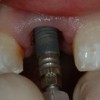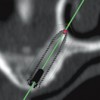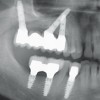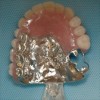A variety of posterior tooth forms have evolved over the years. The posterior tooth form selected is dependent upon a number of factors including, the physical coordination of the patient, the presence of parafunction, the occlusal forms used in the previous denture, and the jaw relationships. This program discusses these issues in detail and provides a guide to selection of posterior tooth forms for edentulous patients.
Complete Dentures – Criteria for Posterior Tooth Selection — Course Transcript
- 1. 22. Criteria for Posterior Tooth Selection Michael Hamada DDS and John Beumer III, DDS, MS Division of Advanced Prosthodontics, Biomaterials and Hospital Dentistry UCLA School of Dentistry This program of instruction is protected by copyright ©. No portion of this program of instruction may be reproduced, recorded or transferred by any means electronic, digital, photographic, mechanical etc., or by any information storage or retrieval system, without prior permission.
- 2. 14. Posterior Tooth Selection Lingualized Lingualized vs monoplane Monoplane Anatomic Semi-anatomic
- 3. 14. Posterior Tooth Selection Criteria Resorbed or flabby ridges Physical condition of the patient Patients who clench or brux Previous denture occlusion Ridge relationship Immediate dentures
- 4. 14. Posterior Tooth Selection Resorbed or flabby ridges Such conditions, as demonstrated in these two patients, make it difficult to obtain accurate intraoral records and permit movement of the denture bases during function. The poorer the record base stability, the less cusp height is indicated. Exception: Some patients with highly resorbed ridges retain superb tongue control and a reasonably stable denture base. If they are vertical chewers, rather than wide envelope grinders, they will prefer and be able to handle cusp fossa teeth. Such patients are ideal candidates for lingualized occlusal schemes.
- 5. 14. Posterior Tooth Selection Patients with poor neuromuscular control have difficulty accommodating to anatomic occlusions. They are best served with monoplane occlusal schemes. Physical condition of the patient
- 6. Chronic bruxers and grinders 14. Posterior Tooth Selection Anxious, nervous individuals are more apt to brux, which can be especially traumatic to the supporting structures when anatomic posterior denture teeth are used. They are best served with monoplane occlusal schemes.
- 7. Previous denture occlusion 14. Posterior Tooth Selection If the present dentures have anatomic teeth which have not been severely ground or worn and the alveolar ridges are not severely resorbed, anatomic teeth can be used. If the existing denture teeth have been worn flat, nonanatomic teeth may be a better choice.
- 8. Ridge relationship 14. Posterior Tooth Selection A skeletal class II relationship requires nonanatomic posterior teeth or cusp to open fossae teeth which permit multiple contact positions without occlusal interferences . When the greater width of the mandibular arch requires a crossbite, nonanatomic posterior teeth are often used or cusp-fossae with the upper buccal cusps opposing the lower fossae.
- 9. Immediate dentures 14. Posterior Tooth Selection Many dentulous patients, especially those with severely worn dentitions, have a discrepancy between ICP (intercuspal position) and RCP (retruded cuspal position ie centric jaw relation). Removal of the natural teeth will permit and encourage a retrusive shift in mandibular posture. If so cusp fossae or monoplane posterior denture teeth should be used.
- 10. Immediate dentures 14. Posterior Tooth Selection A single denture opposing natural dentition will require cusp teeth. Since artificial teeth have their own morphology they do not occlude well against natural teeth unless the natural teeth are recontoured via enameloplasty to better receive the prosthetic teeth. In the case of maxillary denture opposing mandibular natural teeth the most likely, practical occlusal scheme will use the mandibular buccal cusps as the functional cusps opposing the maxillary fossae
- 11. Choices Lingualized 14. Posterior Tooth Selection
- 12. Choices Semi-anatomic 14. Posterior Tooth Selection
- 13. Choices Lingualized vs Monoplane 14. Posterior Tooth Selection
- 14. Choices Monoplane 14. Posterior Tooth Selection
- 15. Choices Anatomic 14. Posterior Tooth Selection
- 16. Good Residual Ridges Well Coordinated Patient Previously successful with anatomic dentures Denture opposes natural dentition When “Lingualized” occlusion is desired Indications for Application Poor Residual Ridges Poor Neuromuscular control (Bruxers, CP etc.) Previously successful with Monoplane Dentures or Severely worn occlusion on previous denture Arch discrepancies Class II or III or Cross-bite Immediate Dentures except when opposing natural dentition Potential poor follow-up Monoplane Occlusion Anatomic Denture Teeth
- 17. No vertical component to aid in shearing during mastication Occlusal adjustment impairs efficiency unless spillways and cutting edges restored Patients may complain of lack of positive intercuspation position Somewhat esthetically limited (don’t look like natural teeth) Monoplane Occlusion Reduction of horizontal forces CR can be developed as an area instead of a point Freedom of movement Can develop solid occlusion despite arch alignment discrepancies Easily adapted to situations prone to denture base shifting Easy to set and adjust teeth Advantages Disadvantages
- 18. Difficult to set Less adaptable to arch relation discrepancies Horizontal force development due to cusp inclinations Harmonious balanced occlusion is lost with denture base settling Requires frequent follow-up and may require more frequent relines to maintain proper occlusion Anatomic Occlusion Definite point of positive intercuspation may be developed Esthetically similar to natural dentition Tooth-to-tooth and cusp-to-cusp balanced occlusion can be achieved Maintains some shearing ability after moderate wear Advantages Disadvantages
- 19. Good esthetics Freedom of non-anatomic teeth Potential for bilateral balance Centralizes vertical forces Minimizes tipping forces Facilitates bolus penetration (mortar and pestle effect) Lingualized Occlusion High esthetic demands Severe mandibular ridge atrophy Displaceable supporting tissues Malocclusion Previous successful denture with Lingualized Occlusion Indications for use Advantages


 Single Tooth Defects in Posterior Quadrants
Single Tooth Defects in Posterior Quadrants
 Prosthodontic Procedures and Complications
Prosthodontic Procedures and Complications
 Restoration of Posterior Quadrants and Treatment Planning
Restoration of Posterior Quadrants and Treatment Planning
 Implants and RPDs
Implants and RPDs
